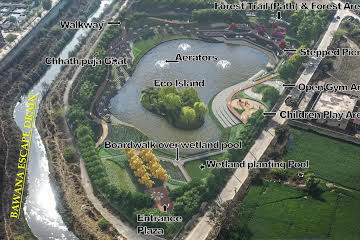Minister of Irrigation & Flood Control Shri Satyendar Jain, on Tuesday, visited the natural Sewage Treatment Plant (STP) at Ghoga Drain and Sannoth Lake. He inspected the natural Sewage Treatment Plant (STP) at Ghoga Drain and directed the officials to increase its water treatment capacity from 10 lakh litres per day to 50 lakh litres per day. Delhi Government is reviving the Sannoth lake with innovative techniques on 6-acres of land at Bawana. Shri Satyendar Jain inspected the construction site. He said that around 3 MGD recycled water from Bawana Common Effluent Treatment Plant (CETP) will be used to rejuvenate the Sannoth Lake.
Shri Satyendar Jain visited the natural Sewage Treatment Plant (STP) at Ghoga drain. This STP is based on a constructed wetland system and treats 10 lakh litres of wastewater per day without electricity or additional power. Shri Jain said, “The water treatment capacity of this STP should be increased from 10 lakh litres per day to 50 lakh litres per day. The recycled water will be used for groundwater recharge by creating a lake in the adjacent area.”
Shri Satyendar Jain also visited Sannoth Lake in Bawana. This lake is being revived by the Delhi Government. The revival work of Sannoth lake is in progress and scheduled to be completed by December 2021.
He further said, “The water holding capacity of the Sannoth Lake should be increased so that more groundwater can be recharged through the lake.”
The Sannoth Lake will receive around 3 MGD clean recycled water from the Bawana Common Effluent Treatment Plant (CETP) after necessary treatment. The I&FC Minister also instructed Delhi State Industrial and Infrastructure Development Corporation Limited (DSIIDC) and Irrigation & Flood Control Department (I & FC) officials to clean the Bawana Escape Drain which has a design discharge capacity of 680 cusecs. This task of cleaning the drain will be jointly done by DSIIDC and I&FC. DSIIDC will ensure that no untreated or unauthorised drain falls into Bawana Escape Drain, while I & FC will ensure that existing water quality flowing in the drains should be improved to the quality parameters laid down by National Green Tribunal (NGT). To this, Shri Jain added, “Weirs should be made in the drain along with floating wetlands and aerators to enhance the treatment of wastewater flowing in the drain.”
The Sannoth lake, which is stretched over 6-acres of land, is located in Bawana’s Sannoth Village. This lake will receive around 3 MGD of clean recycled water from Bawana Common Effluent Treatment Plant (CETP). The lake will have many facilities for the common public such as a playing area for children, a stepped picnic garden, a walkway, Chhath Puja Ghat and an open gym.
Delhi Government is also focusing on preparing a pleasant landscape around Sannoth Lake. The lake will have different species of trees around it. Neem, Bombax, Plumeria, Acacia are some trees that will be planted around the lake.
This project is being executed by Delhi Government’s Irrigation and Flood Control Department. The revival of Sannoth lake will not only aid in groundwater recharge but also create a sustainable ecosystem in the area. The Delhi Government is endeavouring to rejuvenate major water bodies of the Capital. Earlier, the Rajokri lake and the Sanjay Van lake have already been revived by the Delhi Government. The revival of the Sannoth lake will give a boost to this project.
(EW Correspondent)


